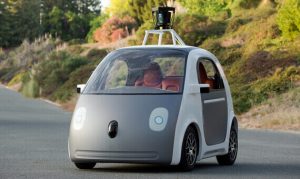If there is something that has characterized us humans since our origins, it has been the fact of wanting to communicate and to communicate in very varied ways: see the child who cries because he is hungry; the employee who works in the sun and in the shade to indirectly obtain a salary increase; a photo on Instagram, uploaded by some of us, waiting in a matter of seconds for the reaction of our followers (not always with the expected likes); the smile of two anonymous cyclists who leave behind a row of cars in a traffic jam; the cave paintings in the Cuevas de Altamira; the shouts of joy for having won a sporting event; or the sense of liberation felt by a scientist, after sleepless nights, because his research has yielded the expected result: his autonomous vehicle is capable of driving without a driver and most importantly, without incident.
“COMMON SENSE” IN THE AGE OF INTELLIGENT MACHINES
Each of these examples discussed immediately above is part of the different ways through which we communicate -and even to refine a little more- we express states, desires, needs or appeal to facts, etc.
What unites all these communicative processes is that, in each specific case, the sender of the message tries to make an intention clear through a common language, which must in turn be interpreted by the receiver in the same way, so that so we can talk about effective communication. Some of these forms of communication or of a common language can be that of the cries of joy at the victory of our team, which unites, for example, the fans of a sports team, and which in turn is not very different from the way in which the spectators of the Roman circus expressed their joy, before the triumph of their cheered gladiator. It would be strange for any spectator or fan to burst into tears before a victory, although of course, you can also cry with joy,
However, the last example, the one that concerns the existence of autonomous vehicles, especially in the laboratories of the engineers who program them, is not a “sine qua non” condition, so that there were many pedestrians who, in the middle of 2019, dare to cross the street in front of a vehicle without a driver and directed only by software. What is this example trying to tell us? That before taking that leap to introduce a new form of “intelligent” communication between humans, there must have been a pattern of behavior, which, already widely accepted by a majority, manages to establish itself as a standard endowed with meaning for the members of the group. a group, society, or nation.
So to speak, the “common sense” shared by the majority would be to wait for this technology to guarantee 100% safety on the roads, if not possible, quite high, in addition to having legal mechanisms that would guarantee us protection against possible infractions or accidents.
LESS COMMON THAN IT SEEMS?
Thus, many authors and from different disciplines have tried to define what is meant by common sense. Some of the efforts to delimit this term are collected in this article , which sticks specifically to what philosophers such as Aristotle, Descartes and the pragmatists understood by this concept. However, at the end of this same article, the author expresses how complicated it is to define this term with the following words:
“If the concept of common sense is problematic, it is because we take it for granted by thinking that, living similar experiences, we all draw similar conclusions from them. At the moment of truth, there is nothing that guarantees that this is the case”.
Since it seems that both mobile phones and WhatsApp-type messaging systems have always been with us (although not even 15 years ago), I invite you to do a little experiment. The test consists for all those who currently have relatives over 90 years old (to choose a somewhat random age) to put on wireless headphones (they are even more striking) and tell them to ask their virtual assistant for music with their voice. correspondent.
Surely there are not two similar reactions, since each one expresses himself in his own way, but I can almost guarantee that many of them, while enjoying a song from the Roaring Twenties, would use an expression similar to “this! it’s magic!” to refer either to an “evil gadget”, or to designate a new “technological milestone” that makes life even more flexible for humans on earth.
FROM RECOGNIZING CERTAIN PATTERNS TO CREATING THEM ARTIFICIALLY
The examples cited seem to speak for themselves and if we analyze them metaphorically through a “social microscope”, it is not so easy to deny or affirm that there is a certain common sense, which is what has allowed us and allows us to evolve. or, to use a concept that is increasingly dominating the techno-scientific world, having emerged. Popular science writer Steven Johnson talks about this term, and its scope, in his book Emerging Systems, or What Ants, Neurons, Cities, and Software Have in Common .
With emergency, Johnson refers to “intelligent behaviors” that not only concern the human species but also ant colonies, cities and the functioning of the network of networks, to cite some of the examples mentioned in the book. And it is that it is this set of cases, surely not chosen at random, that serve Johnson to explain how the agents of a lower level adopt behaviors typical of a higher level, that is, the ants create colonies; urban neighborhoods; and software programs an intelligent internet.
Each of these behavior patterns undoubtedly contains its own language, and obviously in many cases indecipherable by and for the human being, such as the way in which ants communicate by using pheromones, sounds and touch. . Although we also have other cases of an even more complex nature, such as unraveling why cities, which are plunged into apparent chaos, function fluidly and even in an orderly manner, even when the volumes of traffic jams at peak hours could tell us just the opposite.
Apparently there is some kind of similarity that unites all these cases and it is what Steve Johnson calls self-organization, which he himself describes as: “that which makes you become more and more intelligent over time with the ultimate purpose of respond to changing and specific needs of a given environment”. And he adds: “we started building self-organizing systems in our software applications, in video games, in art and music. We’ve built emerging systems to recommend new books, recognize voices, find friends.”
Since the beginning of their existence, complex organisms have lived under the laws of self-organization, but in recent years our lives have been invaded by artificial emergence.

USING ARTIFICIAL INTELLIGENCE TO “PROGRAM” OUR COMMON SENSE
Now, is everything that can be designed, programmed and put into operation advisable and desirable? At what point in the development of artificial intelligence did ethics begin to play an important role? Undoubtedly, one of the key moments was in 2016, when the first death by an automatically piloted car occurred, as reported
This fact marked a point of inflection and reflection to try to change, rectify and even create legislation to make room for a new technological, social and economic reality if you want to extrapolate to all the areas affected, which until then it was more a part of science fiction movies than of the public roads of any place in the world.
It is these extreme events, which in many cases unfortunately correspond to dramatic events, which make the structure evolve until then static of a society, which is practically doomed to certain disasters, as there are no legislative mechanisms, nor any dialogue among the professionals in charge of both the ideation, implementation and regulation of these new scenarios.
While in Europe the regulation of artificial intelligence is a fact, in other countries such as China, there is a legal vacuum or a certain opacity regarding the regulation of these emerging technologies. This Asian country was in the news again a few months ago for the introduction of so-called smart uniforms in various educational centers, which allow, among other things, as described here , to control the entry and exit of students from the school in the name of increasing the efficiency.
ARCHITECTS OF “COMMON SENSE”, A PARADOX TO BE RESOLVED
Perhaps a day will come when we will rely more on software to drive a vehicle or an airplane than on a human. We will not be able to say if the vehicle will be endowed with common sense, but perhaps that specific technology will have reached a level of perfection that car accidents, which today are still one of the main causes of death in the world, are From the past.
In the same way, I wonder if the artificial intelligence systems in China, which are already in charge of super-surveillance of its citizens, could develop that common sense so longed for by humans by machines, being able to discern to what extent they spy to the subject they monitor, without damaging what is still called privacy and refusing to provide certain information to their own creators. This future and currently unrealistic scenario would put the future of humans as well as that of machines in a win-win relationship.

